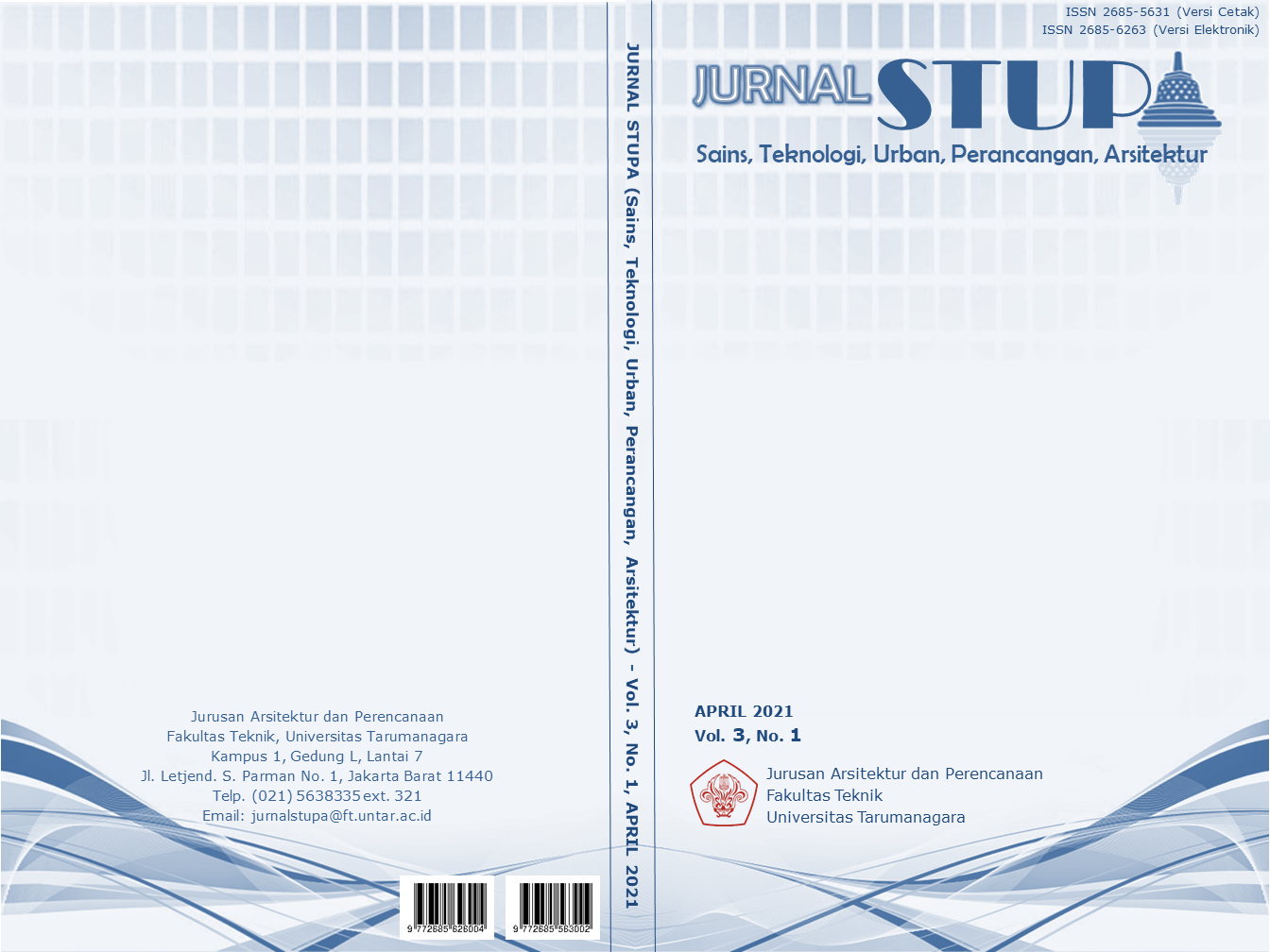SARANA PENGEMBANGAN KOMUNITAS PENGRAJIN FURNITUR KLENDER YANG BERBASIS PADA KESEHATAN LINGKUNGAN KERJA PENGRAJIN
Main Article Content
Abstract
The way of a person, a group of people, and a community to dwell in certain area depends on their settlement process. The process of living is formed by experiences, events, and problem solving in the past. The accumulation of the habitual process experienced by a community in an area forms an image of the area. The image of the area formed by this way of living also occurs in Klender area, East Jakarta. The image formed is furniture industry center for Jakarta and the cities nearby. Although having an image of the furniture industry center, there are still many problems in the industry process. Starting from the problem with the workforce, the technology, worker’s respiratory health, until how to promote the product. Seeing the existing problems and needs, we can find a solution by human development in the furniture industry. The development of furniture industry includes solutions to advance the industry towards the future. The design approach used in this project is pragmatic design method that is oriented towards the direct benefits which can be seen. Of course the direct benefits are facilities that can improve the human resource in the modern furniture industry with the knock down industry system. Also creating a healthy working environment for the craftsmen. These facilities include training education in design, production and technology. In addition, it creates a healthy working environment, in this case a healthy air circulation for the craftsmen. The healthy air circulation system mentioned before is creating dust collector system and air filter system in the production area. The purpose of these ideas are of course to improve the quality of inhabitants of the community in terms of their work in the furniture industry so that they can compete in the domestic and foreign markets during the Covid pandemic and afterwards.
Keywords: Furniture industry; Klender; Carpenter
Cara berhuni seseorang, sekelompok orang, dan suatu komunitas di satu kawasan bergantung pada proses berhuni mereka. Proses berhuni dibentuk dari pengalaman, kejadian, dan pemecahan masalah di masa lampau. Akumulasi dari proses berhuni yang dialami komunitas di suatu kawasan membentuk citra kawasan. Citra kawasan yang terbentuk dari cara berhuni ini juga terjadi di kawasan Klender, Jakarta Timur. Citra kawasan yang terbentuk adalah Klender sebagai pusat industri furnitur bagi Kota Jakarta dan sekitarnya. Walaupun memiliki status sebagai pusat industri furnitur, tidak juga terlepas dari berbagai masalah. Mulai dari tenaga kerja yang kurang menguasai teknologi modern, lingkungan kerja yang buruk bagi kesehatan pernafasan pengrajin, dan sektor promosi yang kurang berkembang. Melihat masalah dan kebutuhan yang ada, dapat dilakukan pengembangan industri furnitur yang ada di Kelurahan Klender. Pengembangan industri furnitur ini mencakup solusi untuk memajukan industri menatap masa depan. Pendekatan desain yang dilakukan pada penelitian ini adalah melalui metode desain pragmatis, yaitu desain yang berorientasi pada manfaat langsung yang dapat dihasilkan. Tentu manfaat yang ingin dihasilkan adalah fasilitas yang dapat meningkatkan kemampuan pengrajin furnitur dan yang memiliki lingkungan kerja yang sehat. Fasilitas ini mencakup pelatihan dan pendidikan tenaga kerja dalam hal desain, produksi, dan teknologi. Selain itu, menciptakan lingkungan kerja dalam hal ini sirkulasi udara yang sehat bagi pengrajin. Selain itu, menciptakan sistem pembuangan serbuk kayu dan filter udara untuk menciptakan lingkungan kerja yang sehat di area produksi. Tujuan dari pengembangan ini tentunya untuk meningkatkan kualitas berhuni masyarakat dalam hal pekerjaan mereka di bidang industri furnitur supaya dapat bersaing di pasar domestik maupun mancanegara di masa pandemi covid ini dan sesudahnya.
Article Details
References
Anupama, S., Dhote, K. (2003). Climatic Responsive Energy Efficient Passive Techniques in Building. Bhopal : Maulana Azad National Institute of Technology.
Certeau, M. (1998). The Practice of Everyday Life. Minnesota: The Regents of the University of Minnesota.
Christina, N., Yong, S., Basuki, L. (2019). Perancangan Interior Sentra Galeri dan Workshop Kerajinan Kayu di Blora, Jawa Tengah. Surabaya : Program Studi Desain Interior, Universitas Kristen Petra.
Heidegger, M. (1971). Building Dwelling Thinking. New York: Harper Colophon Books.
Nur, E. (2011). Klaster Industri Mebel Klender. Fakultas Matematika dan Ilmu Alam Universitas Indonesia.
Stefanny, M. Indrayani, R. (2013). Pengelolaan dan Pengembangan Usaha Furniture pada Aspek Pemasaran CV. Megahtama Cemerlang. Surabaya: Program Manajemen Bisnis, Program Studi Manajemen, Universitas Kristen Petra.
Stone, A., Carr, S., Francism, M., Rivlin, L. (1992). Public Space. Cambridge: Cambridge University Press.
Wijayanti, Dika Novi. Utomo, Tri Noviyanto. Susan, Maria Yohana. Perancangan Furnitur Serta Fasilitas Pendukungnya dengan
Menggunakan Material Ramah Lingkungan. (2017). Surabaya: Arsitektur Interior, Universitas Ciputra.
Furniture Cetakan 3d Akan Banjiri Rumah Masa Depan, fomustudio.com, diakses tanggal 14 September 2020, https://fomustudio.com/furnitur-cetakan-3d-design-akan-banjiri- rumah-masa-depan/
Alur Proses Pembuatan Furnitur, klikteknik.com, diakses tanggal 18 September 2020, https://www.klikteknik.com/blog/alur-proses-pembuatan-furniture.html



